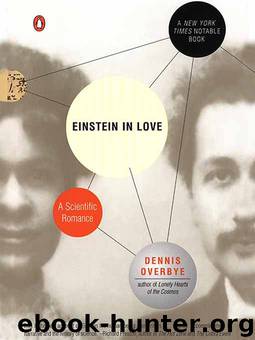Einstein in Love by Dennis Overbye

Author:Dennis Overbye
Language: eng
Format: epub
Publisher: Penguin Publishing Group
Published: 2002-04-04T05:00:00+00:00
WHAT CAME TO be known as the First Solvay Congress thus cast long shadows personally and stylistically, as well as scientifically. It was followed by a series of biennial summit meetings that ran into the 1930s. These congresses helped inaugurate a new style of international celebrity science: conferences jointly sponsored by corporations, government agencies, and universities at resort hotels, organized around a particular problem or field, drawing experts from around the world. Although today these scientists can be seen scribbling their talks on airplanes as they jet from enclave to enclave, the world in 1911 was much smaller, and they rode trains from Berlin to Leiden to Göttingen to Zurich to Paris to Vienna in upholstered comfort, sipping coffee, changing currency and language at each frontier as casually as a man trading his scarf for another one. Whereas Albert once had been a man without a country, he was now a member of a society almost above country, with a passport stamped by God—or at least Lorentz—admitting him to the company of saints, sinners, feuders, egomaniacs, neurasthenics, and worshipers and granting him all the privileges accruing thereto, namely the right to make pronouncements about the universe and then to fall flat on his face.
Of all the pronouncements in Albert’s young career, none had been greeted with more incredulity and had survived against higher odds than his suggestion that light was composed of quanta. In the decade leading up to the Brussels meeting, no one had done more to breathe fire into the strange embers that Planck had discovered. As much as the Solvay Congress marked Albert’s debut on the international scientific stage, it served as the formal debut of the quantum, enshrining it as the central scientific mystery of the modern age. The Solvay conferees did not solve the mystery of the quantum, but in the aftermath of the meeting a series of advances showed just how strange and deep the quantum mystery was, and how prescient Albert had been to worry about it.
It fell to the grinning New Zealander in the group portrait, Ernest Rutherford, to take the next step inward toward the quantum. Although atoms were now acknowledged to exist, their constitution was still a mystery. According to the most favored theory, sometimes known as the Plum Pudding model, put forth by J. J. Thomson, an atom consisted of a large, amorphous ball of positive electrical charge studded with thousands of tiny negatively charged electrons. By the time of the Solvay Congress, Rutherford had already been getting indications that this prototype was incorrect, but it was too early in his research to publish any formal report. At his laboratory in Manchester Rutherford had been experimenting with a form of radioactivity called alpha rays, which were actually positively charged helium atoms that came shooting like bullets out of the Curies’ radium samples. When he in turn aimed these “bullets” at a sheet of gold foil most of them passed through it as if nothing stood in their way. About one in eight thousand, however, bounced straight back.
Download
This site does not store any files on its server. We only index and link to content provided by other sites. Please contact the content providers to delete copyright contents if any and email us, we'll remove relevant links or contents immediately.
Enlightenment Now: The Case for Reason, Science, Humanism, and Progress by Steven Pinker(7235)
A Journey Through Charms and Defence Against the Dark Arts (Harry Potter: A Journey Through…) by Pottermore Publishing(4781)
The Immortal Life of Henrietta Lacks by Rebecca Skloot(4525)
A Journey Through Divination and Astronomy by Publishing Pottermore(4344)
Elon Musk by Ashlee Vance(4032)
Origin Story: A Big History of Everything by David Christian(3649)
COSMOS by Carl Sagan(3554)
Alchemy and Alchemists by C. J. S. Thompson(3451)
Bad Pharma by Ben Goldacre(3356)
Enlightenment Now by Steven Pinker(3338)
Shadow of Night by Deborah Harkness(3303)
Inferior by Angela Saini(3276)
A Mind For Numbers: How to Excel at Math and Science (Even If You Flunked Algebra) by Barbara Oakley(3221)
Origin Story by David Christian(3147)
The Code Book by Simon Singh(3074)
Signature in the Cell: DNA and the Evidence for Intelligent Design by Stephen C. Meyer(3071)
The Elements by Theodore Gray(2998)
A Brief History of Time by Stephen Hawking(2962)
A Journey Through Potions and Herbology (A Journey Through…) by Pottermore Publishing(2828)
